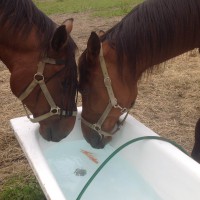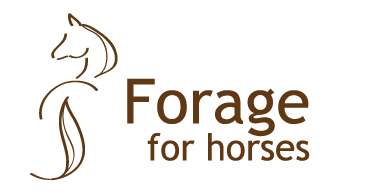Horses’ fluid balance

Fluid is constantly lost from the body via urine and faeces, but fluid is also lost via evaporation from the body and the respiratory ways. To maintain the body’s water content is necessary for life, water participates in just about all essential processes in the body. During fluid loss the sodium concentration in the blood increases and this leads to a decreased fluid loss via the urine and thirst is stimulated. When there is an excess of fluid in the body the sodium concentration in the blood decreases and the excretion of fluid via the urine increases.
One way to study the horse’s fluid balance is to measure the horse’s water intake and water excretion. That is how much water the horse drinks plus how much water it gets via the feed and how much water is lost via faeces and urine. By subtracting the horse’s total water excretion from the total water intake ((drinking + via feed) – (via faeces + via urine)) we get an estimated value of the horse’s evaporation.
Another way to evaluate the horse’s fluid balance is to measure the horse’s plasma volume. However, measuring plasma volume is easier said than done and therefore indirect methods are often used. One way to indirect measure the horse’s plasma volume is to analyse the concentration of proteins in plasma, TPP (total plasma protein). High concentration of TPP shows lower plasma volume and low concentration of TPP means larger plasma volume.
The horse’s hindgut functions as a fluid reservoir and this is due to fibres’ capacity to bind water. Fibre, and especially soluble fibre, has high water-holding capacity and with a high forage diet the horse consumes a lot of fibre and therefore gets a larger water reservoir than on a low forage high concentrate diet. The dry matter (DM) concentration of the intestinal content is also affected by the horse’s diet. When horses are fed high concentrate diets DM concentrations of up to 9.9% in caecum and 15.9% in colon have been measured. On a forage-only diet DM concentrations as low as 4.5% in caecum and 4% in colon have been measured. When horses cannot maintain normal fluid balance fluid is shifted from the hindgut to compensate and protect the fluid volume of the body and then the risk of constipation and colic can increase.
The horse’s fluid balance is important to have in mind when horses exercise and perform and here you can read more about differences in horses’ fluid balance when they consume hay and silage, that forage-only diets have positive effects on fluid balance, forage crude protein content and horses’ nitrogen metabolism and water intake and forage intake – effects on performance. Here you can read more about horses’ water intake and that the equine hindgut is a fluid reservoar.
Sara Muhonen, AgrD
Meyer H & Coenen M 1989 Influence of exercise on the water and electrolyte content of the alimentary tract. In: Proceedings of the 11th Equine Nutrition and Physiology Symposium, Oklahoma State University, US, pp. 3-7.
Meyer H 1987 Nutrition of the equine athlete. In: Equine Exercise Physiology 2 (Eds. Gillespie JR, Robinson, NE) Davis, CA: ICEEP publications, pp. 644-673.
Nyman S 2001 Water intake and fluid regulation in the horse. Doctoral thesis. Acta Universitatis Agriculturae Sueciae 2001:98.
